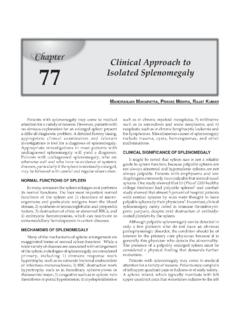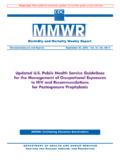Transcription of Clinical versus the public health approaches - epidemiolog.net
1 _____ , Victor J. Schoenbach 2000 17. Epidemiology and public health - 551 rev. 10/23/1999, 1/17/2000, 3/23/2001 17. Epidemiology and public health Clinical versus the public health approaches In their report of a major study conducted by the National Academy of Science's Institute of Medicine, the Committee for the Study of the Future of public health defined the mission of public health mission as: "the fulfillment of society's interest in assuring the conditions in which people can be healthy" (p 40) The substance of public health was defined as: "organized community efforts aimed at the prevention of disease and the promotion of health . It links many disciplines and rests upon the scientific core of epidemiology." (p 41) public health focuses on the health of the community, but is a community an entity other than the people in a particular location or institutional unit? To begin exploring this question, let us first contrast two complementary approaches to maintaining and improving health the Clinical approach and the public health approach.
2 Clinical approach The Clinical approach deals with individuals, families. The provider's mission is to do what is best for the patient. Although it has been criticized for devoting insufficient attention to prevention, Clinical medicine is not inherently tied to curative, rather than preventive approaches . In fact, in recent decades the time and resources devoted to preventing disease have greatly increased, especially in the realm of secondary prevention ( , management of hypertension and hypercholesterolemia). Pediatrics has long emphasized primary prevention. What is more intrinsic to the Clinical approach is the focus on the individual, or sometimes the family, in terms of diagnosis and intervention. Diagnostic inquiry is directed at the patient, , her or his history, experiences, physiology, and so on. The scope of inquiry is primarily the prevention and treatment of medically recognized diseases, trauma, and psychiatric disorders.
3 Preparation of clinicians emphasizes core knowledge in biomedical sciences oriented towards understanding physiological and pathological processes, the effects of pharmacologic and surgical interventions, and techniques for investigation and intervention with the individual. In addition to allopathic medicine, numerous other approaches are offered in a Clinical -type setting, including acupuncture, chiropractic, massage therapy, and many others. But the Clinical encounter with an individual remains the framework. _____ , Victor J. Schoenbach 2000 17. Epidemiology and public health - 552 rev. 10/23/1999, 1/17/2000, 3/23/2001 public health approach The public health approach, in its ideal concept, deals with communities. The public health mission is to serve the community, even when particular individuals may well be disadvantaged in some way. There is some ambiguity in this statement, though, since any given population may be regarded as consisting of various "communities", whose interests are often perceived to differ.
4 But typically public health focuses on a population or on subgroups within it. The public health approach emphasizes prevention, though prevention in this context generally means preventing the occurrence of disease in individuals. At the level of the community, the distinction between prevention and cure may not be as clear. The scope of public health is much broader than that of the Clinical approach, because there is no framework of a Clinical encounter to confine the time for diagnosis or intervention, and the variety of people and their situations in a community multiply the range of factors that can affect health . Therefore, in addition to specific and general causes of medically-recognized diseases, trauma, and psychiatric disorders, public health is concerned with the organization of society and the protection of the environment, and properly focuses on the future. public health providers have a small core of common training, due to the many fields of knowledge that become relevant when one deals with factors outside the individual.
5 Channels for intervention are similarly broad, as they can deal with individuals, families, government organizations, the media, and the physical environment. Contrasting the Clinical and public health approaches Two WHO reports on in vitro fertilization (IVF), published two years apart, illustrate the contrast in the Clinical and public health approaches . The first (1990), issued by the WHO Regional Office for Europe in Copenhagen used a public health approach aimed at finding the best mix of curative and preventive health services, given existing resources, to maximize health status. The second (1992), issued by the WHO headquarters in Geneva, used a Clinical approach to health policy development and focused on individual patients and their available treatment options. Here are some examples of these contrasting perspectives, taken from a commentary by Stephenson and Wagner (1993): Prevention y Copenhagen - options and recommendations for integration of preventive health services into an overall plan for the management of infertility in the community y Geneva - no discussion of the prevention of infertility health services planning y Copenhagen - a technology or procedure should have proven effectiveness, safety, and benefit as evaluated by Clinical trials and other epidemiology methods, before acceptance as standard treatment.
6 _____ , Victor J. Schoenbach 2000 17. Epidemiology and public health - 553 rev. 10/23/1999, 1/17/2000, 3/23/2001 y Geneva - " .. IFV and allied procedures changed from being purely experimental in character to become accepted treatments for certain types of infertility and the numbers of centres offering them increased rapidly." Rationing of health care y Copenhagen - provision of services should be determined by the prevalence of the condition, the priority for infertility services within all human services, the medical and social options available to infertile people, and consumer views and choices. The public must have a voice in setting these priorities. y Geneva - "Respect for the principle of quality of services requires the availability of medically assisted conception to the population requiring such service." Standards of practice y Copenhagen - recommendations for limits on age (40 years of age or younger), number of IVF treatment cycles per woman, and three eggs/embryos per IVF treatment cycle.
7 Y Geneva - no recommendations Research priorities y Copenhagen - priority to epidemiological, social, and health services research y Geneva - focuses on laboratory and Clinical problems The individual and population approaches have also been contrasted in regard to the epidemiology and prevention of sexually transmitted diseases and HIV (Aral et al., 1996). Overlap To be sure, there is considerable overlap between the two approaches , which at its best provides many opportunities for cooperation and complementary services and at its worst invites charges of duplication and turf wars. From the Clinical side, the importance of prevention is being increasingly emphasized in primary care; from the public health side, interventions directed at the individual ( , inoculation, early detection and treatment, risk factor management) are typically carried out in one-on-one Clinical settings. Pediatrics particularly has a strong orientation to prevention, and there are also disciplines of community medicine, community pediatrics, and social medicine.
8 There are also many activities and organizations that blend both Clinical and public health approaches , as, for example, public health clinics, outreach services, patient education, Clinical dietetics, Clinical epidemiology, and questions of the availability, effectiveness, quality, and affordability of health services. Obviously, both Clinical and public health approaches are essential. Without health care at the individual level, much suffering occurs. Without public health , the brushfires of disease can easily overwhelm treatment resources. There is, however, a growing concern that the Clinical approach has been gaining ascendency in confronting health needs out of proportion to the needs of public _____ , Victor J. Schoenbach 2000 17. Epidemiology and public health - 554 rev. 10/23/1999, 1/17/2000, 3/23/2001 health , particularly at the world level.
9 Among the factors that favor the Clinical approach over public health are: y Symptoms and discomfort tend to motivate action much more than do theoretical concerns about low-level risks in the future. y Individual victims of disease can be (or be made) highly visible and can elicit sympathy and a desire to help; by contrast, benefits from effective public health tend to be invisible and abstract. y Effective treatment of a feared or disabling condition is highly visible and can be dramatic; by contrast, beneficiaries of effective public health measures typically do not think of themselves as being at risk nor as having benefited. y Groups of individuals who have been affected by a disease can be highly influential in the political process; by contrast, public health benefits large groups, so specific individuals are not moved to action. y health care insurance systems provide an enormous revenue stream to support Clinical services; by contrast, public health must compete with numerous other worthy constituencies for government appropriations.
10 Y Clinical professions have many more people than do public health professions, which means more visibility, more potential letter-writers, and more membership dues for professional organizations. y Much Clinical care is delivered by the private sector, which has much greater ability to market its services and perspectives. Thus, it is hardly surprising that resources devoted to health care services are orders of magnitude greater than those devoted to public health . Nevertheless, nations differ in their relative expenditure on public and private health services, and there are opportunities to influence the balance through public education ( marketing) campaigns. Academic versus public health perspectives As noted in an earlier chapter, the modern history of public health has been shaped by advances in scientific knowledge and technology, and growth in the public 's acceptance that disease control is possible and a public responsibility.

















